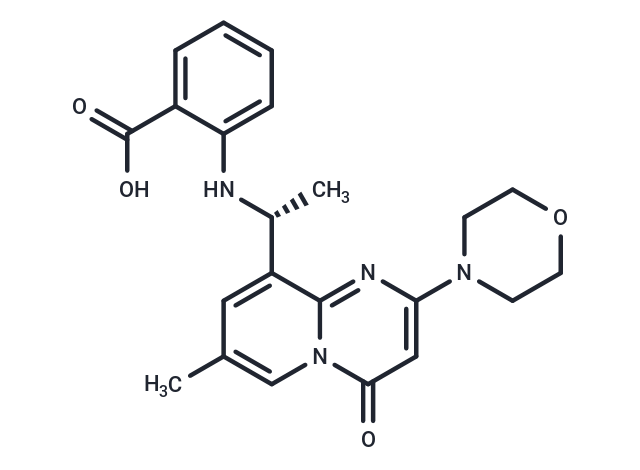Shopping Cart
- Remove All
 Your shopping cart is currently empty
Your shopping cart is currently empty

AZD 6482 (KIN-193) is a potent and selective inhibitor of p110β and PI3Kβ with IC50 values of 0.69nM and 10nM, respectively. AZD 6482 is particularly effective in blocking AKT signaling and tumor growth dependent on p110β activation or PTEN loss.

| Pack Size | Price | Availability | Quantity |
|---|---|---|---|
| 1 mg | $31 | In Stock | |
| 5 mg | $72 | In Stock | |
| 10 mg | $123 | In Stock | |
| 25 mg | $198 | In Stock | |
| 50 mg | $372 | In Stock | |
| 100 mg | $548 | In Stock | |
| 1 mL x 10 mM (in DMSO) | $64 | In Stock |
| Description | AZD 6482 (KIN-193) is a potent and selective inhibitor of p110β and PI3Kβ with IC50 values of 0.69nM and 10nM, respectively. AZD 6482 is particularly effective in blocking AKT signaling and tumor growth dependent on p110β activation or PTEN loss. |
| Targets&IC50 | PI3Kβ:10 nM, p110β:0.69 nM |
| In vitro | METHODS: U87 and U118 cells were treated with AZD 6482 (KIN-193) (0.625, 1.25, 2.5, 5, 10, 20, 40 μM, 48 hours), and CCK8 was used to measure its inhibitory effect on the proliferation of U87 and U118 cells. RESULTS AZD 6482 inhibited the viability of both cell lines in a dose-dependent manner, with U118 cells being more sensitive than U87 cells, with IC50 values of 7.989 and 9.061 μM, respectively. [4] |
| In vivo | METHODS: Mice with HCC70, PC3, and HCC1954 xenograft tumors were treated with AZD 6482 (KIN-193) (20 mg/kg, i.p., twice daily) or GDC-0941 (150 mg/kg, orally, once daily). Study the in vivo effects of KIN-193 on PTEN-deficient tumors. RESULTS AZD 6482 significantly inhibited tumor growth of HCC70 and PC3 tumors but failed to block the growth of HCC1954 tumors. [2] |
| Kinase Assay | Assay of PI3K enzyme inhibition: The inhibition of PI3Kβ, PI3Kα, PI3Kγ, and PI3Kδ is evaluated in an AlphaScreen based enzyme activity assay using human recombinant enzymes. The assay measures PI3K-mediated conversion of PIP2 to PIP3. Biotinylated PIP3, a GST-tagged pleckstrin homology (PH) domain and the two AlphaScreen beads form a complex that elicits a signal upon laser excitation at 680 nm. The PIP3 formed in the enzyme reaction competes with the biotinylated PIP3 for binding to the PH domain thus reducing the signal with increasing enzyme product. The AZD6482 is dissolved in DMSO and added to 384 well plates. PBKβ, PBKα, PBKγ, or PBKδ is added in a Tris buffer (50 mM Tris pH 7.6, 0.05% CHAPS, 5 mM DTT, and 24 mM MgCl2) and allowed to preincubate with AZD6482 for 20 minutes prior to the addition of substrate solution containing PIP2 and ATP. The enzyme reaction is stopped after 20 minutes by addition of stop solution containing EDTA and biotin-PIP3, followed by addition of detection solution containing GST-grpl PH and AlphaScreen beads. Plates are left for a minimum of 5 hours in the dark prior to analysis. The final concentration of DMSO, ATP and PIP2 in the assay are, 0.8%, 4 μM, and 40 μM, respectively. IC50 values are calculated according to the equation, y = {a+[(b-a)/(l+(x/IC50)s)]}, where y = % inhibition; a = 0%; b = 100%; s = the slope of the concentration-response curve; x = AZD6482 concentration. |
| Cell Research | For assay of washed platelet aggregation (WPA), the platelet pellets are isolated from human blood and re-suspended to 2 × 1015/L in Tyrodes buffer (TB) containing 1 μM hirudin and 0.02 U/mL apyrase. Then, the platelet suspension is left to rest at room temperature for 30 min. Just prior to time for assay, CaCl2 is added to a final concentration of 2 mM. AZD6482, dissolved in DMSO, is added to a 96-well plate prior to the addition of the washed platelet suspension. The platelet suspension is preincubated with AZD6482 for 5 min. Light absorption at 650 nm is recorded before and after a 5 min plate shake and referred to as recording 0 (R0) and Rl. A mouse anti-human CD9 antibody is added (at a donor specific concentration) to each well prior to next 10 min plate shake and light absorption recording; R2. For data analysis, light absorbance in wells with TB are subtracted from all readings before percent aggregation is calculated according the formula: [(R1-R2)/R1] × 100 = % aggregation. Spontaneous aggregation or pro-aggregatory effect of the inhibitor is evaluated by the same formula, [(R0-Rl)/R0] × 100 = % aggregation. IC50 values are calculated according to the equation, y = {a+[(b-a)/(l+(x/IC50)s)]}, where y = % inhibition; a = 0%; b = 100%; s = the slope of the concentration-response curve; x = AZD6482 concentration. (Only for Reference) |
| Alias | KIN 193, AZD6482 |
| Molecular Weight | 408.45 |
| Formula | C22H24N4O4 |
| Cas No. | 1173900-33-8 |
| Smiles | C[C@@H](Nc1ccccc1C(O)=O)c1cc(C)cn2c1nc(cc2=O)N1CCOCC1 |
| Relative Density. | 1.36 |
| Storage | Powder: -20°C for 3 years | In solvent: -80°C for 1 year | Shipping with blue ice. | |||||||||||||||||||||||||||||||||||
| Solubility Information | DMSO: 45 mg/mL (110.17 mM), Sonication is recommended. | |||||||||||||||||||||||||||||||||||
Solution Preparation Table | ||||||||||||||||||||||||||||||||||||
DMSO
| ||||||||||||||||||||||||||||||||||||

Copyright © 2015-2025 TargetMol Chemicals Inc. All Rights Reserved.